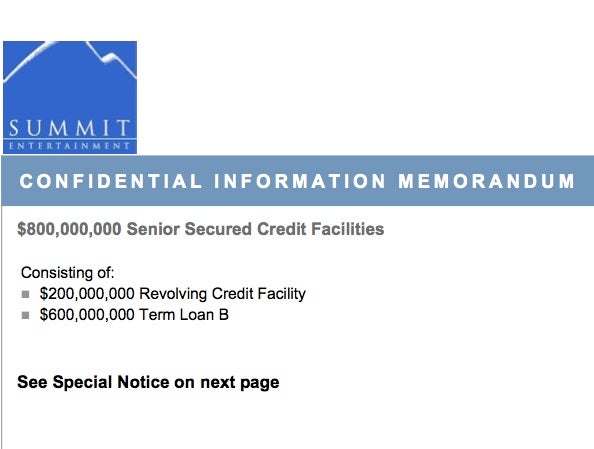EXCLUSIVE
Summit’s two coming blockbusters, “Breaking Dawn 1 and 2” will cost $263 million — not the $200 million previously reported — and are projected to bring in a staggering $1.2 billion for the studio, according to confidential documents obtained by TheWrap.
The documents were part of the prospectus used to borrow $750 million in capital this week for Summit Entertainment (Click here to read most of the memo).
 The prospectus contains a wealth of data and insight into one of the few privately-held movie studios, and reveals how Summit has successfully leveraged the “Twilight” franchise and mitigated its risk through foreign pre-sales (see chart above).
The prospectus contains a wealth of data and insight into one of the few privately-held movie studios, and reveals how Summit has successfully leveraged the “Twilight” franchise and mitigated its risk through foreign pre-sales (see chart above).
Also read: ‘Twilight Saga’ — the Making of a Bargain Blockbuster
Summit declined to comment about the document.
The papers also detail the reasons behind the refinancing. Summit Entertainment, now four years old into its current incarnation, will repay its original investors a $200 million dividend with the massive loan.
The largest investor, Peak Capital Investment, a consortium that includes Rizvi Traverse and Participant, stands to recoup nearly $100 million from its 48 percent stake (see chart on page 2).
But the biggest news may be the cost structure behind the fourth and fifth installments of Summit’s blockbuster Twilight franchise. “Breaking Dawn 1” will cost $127.5 million, but according to the documents Summit only has $38.4 million at risk. The film will be released in November 2011.
The second film, “Breaking Dawn 2,” cost $136.2 million, with Summit’s exposure limited to $51.2 million, according to the documents.
The studio anticipates revenues of $1.2 billion related to just those two pictures, the documents say. They are projecting a profit of $228 million for the first film and $219 million for the second for a total of nearly $450 million.
just those two pictures, the documents say. They are projecting a profit of $228 million for the first film and $219 million for the second for a total of nearly $450 million.
The budgets of “Breaking Dawn” may be higher than expected, but they are relatively modest when compared to other Hollywood blockbusters.
Nonetheless, the costs have skyrocketed from the first film, when the studio put up a mere $37 million for “Twilight” and reaped $231 million in profits.
Clearly, it was a good time to cash in some chips.
“This enables long term investors to cash out some return from the great success of the ‘Twilight’ franchise,” Harold Vogel, head of Vogel Capital Management, told TheWrap.
The company will pay 7.5 percent interest on the loan over five and a half years, according to Wall Street reports after the deal closed on Tuesday.
The timing makes sense for Summit’s investors, if only because the studio has little in the pipeline that seems destined to replicate the phenomenal success of “Twilight.”
After all, “Twilight” has a natural expiration date, with the final two parts in the franchise due for release over the next two years.
Indeed, the prospectus to investors from UBS and J.P. Morgan paints a picture of a company that generated hundreds of millions of dollars in profits almost exclusively on the back of its hit vampire franchise.
On the strength of “Twilight” and its two sequels, Summit went from a start-up studio that lost $76.5 million in 2008 to a Cinderella story with $340.9 million in profits last year alone.
Though Summit originally was seeking to borrow $800 million, the company did not reduce the size of the dividend to its shareholders even when the amount raised was reduced.
Further demonstrating that the dividend was the main impetus for the refinancing drive, Summit in essence decided to reward its stakeholders at the expense of having an extra $50 million of cash on the balance sheet to fund production and distribution.
Analysts contacted by TheWrap maintain that it will leave Summit on firmer financial footing.
It may also better position the studio to be sold, because it reduces debt and improves the company’s operating expenses.
“The cost of capital has likely been reduced, while long-run availability of capital to weather any box office downturn or misfires will be more assured,” Vogel told TheWrap. “As such, it also puts the company in a better balance sheet position to eventually be acquired, if the major investors ultimately decide to go that route.”
The company plans to use roughly $410 million of cash on its balance sheet to help complete production of the “Breaking Dawn” films, market them, and fund its future films.
Over the next two years, the company told potential investors that it will also make $499 million from other movies and from previously released “Twilight” films.
Not that any of those non-vampire projects are likely to reap substantial dividends by themselves.
Tellingly, in its bid to drum up new funding, Summit focused almost solely on the new “Twilight” films, giving only a passing nod to other studio titles, such as the Bruce Willis thriller “The Cold Light of Day” or the Mel Gibson dramedy “The Beaver.”
Summit has been remarkably conservative in managing its film slate, going heavy on acquisitions, but limiting exposure on the films it produces in-house.
Foreign pre-sales pay for the bulk of the studio’s films. For instance, Summit is putting up only $2 million of the $10 million budget for the immigrantion drama “A Better Life” and $17.5 million of the $34.8 million budget for the thriller “The Darkest Hour.”
(Sharon Waxman contributed to this report.)